STS-47
STS-47 was the 50th Space Shuttle mission of the program, as well as the second mission of Space Shuttle Endeavour. The mission mainly involved conducting experiments in life and material sciences.
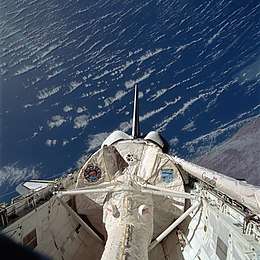 Spacelab Module LM2 in Endeavour's payload bay, serving as the Spacelab-J laboratory | |
| Mission type | Microgravity research |
|---|---|
| Operator | NASA |
| COSPAR ID | 1992-061A |
| SATCAT no. | 22120 |
| Mission duration | 7 days, 22 hours, 30 minutes, 23 seconds |
| Distance travelled | 5,265,523 kilometers (3,271,844 mi) |
| Orbits completed | 126 |
| Spacecraft properties | |
| Spacecraft | Space Shuttle Endeavour |
| Landing mass | 99,450 kilograms (219,250 lb) |
| Payload mass | 12,485 kilograms (27,525 lb) |
| Crew | |
| Crew size | 7 |
| Members | |
| Start of mission | |
| Launch date | 12 September 1992, 14:23:00.0680 UTC |
| Launch site | Kennedy LC-39B |
| End of mission | |
| Landing date | 20 September 1992, 12:53:24 UTC |
| Landing site | Kennedy SLF Runway 33 |
| Orbital parameters | |
| Reference system | Geocentric |
| Regime | Low Earth |
| Perigee altitude | 297 kilometres (185 mi) |
| Apogee altitude | 310 kilometres (190 mi) |
| Inclination | 57.0 degrees |
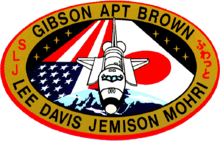 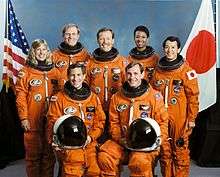 Left to right - Front row: Apt, Brown; Back row: Davis, Lee, Gibson, Jemison, Mohri | |
Crew
| Position | Crew Member | |
|---|---|---|
| Commander | Robert L. Gibson Fourth spaceflight | |
| Pilot | Curtis L. Brown, Jr. First spaceflight | |
| Mission Specialist 1 | Mark C. Lee Second spaceflight | |
| Mission Specialist 2 | Jay Apt Second spaceflight | |
| Mission Specialist 3 | N. Jan Davis First spaceflight | |
| Mission Specialist 4 | Mae C. Jemison Only spaceflight | |
| Payload Specialist 1 | Mamoru Mohri, NASDA First spaceflight | |
Backup crew
| Position | Astronaut | |
|---|---|---|
| Payload Specialist 1 or 2 | Chiaki Mukai, NASDA First spaceflight | |
| Payload Specialist 1 or 2 | Takao Doi, NASDA First spaceflight | |
| Payload Specialist 1 | Stanley L. Koszelak First spaceflight | |
Crew seating arrangements
| Seat[1] | Launch | Landing | 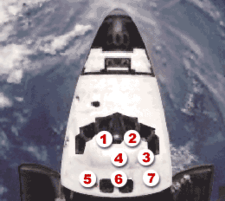 Seats 1–4 are on the Flight Deck. Seats 5–7 are on the Middeck. |
|---|---|---|---|
| S1 | Gibson | Gibson | |
| S2 | Brown | Brown | |
| S3 | Lee | Davis | |
| S4 | Apt | Apt | |
| S5 | Davis | Lee | |
| S6 | Jemison | Jemison | |
| S7 | Mohri | Mohri | |
Mission highlights
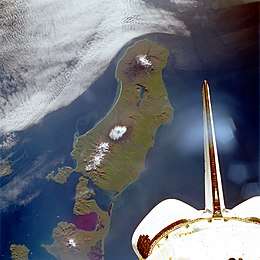
Spacelab-J—a joint NASA and National Space Development Agency of Japan (NASDA) mission using a crewed Spacelab module—conducted microgravity investigations in materials and life sciences. The international crew, consisting of the first Japanese astronaut to fly aboard the Shuttle, the first African-American woman to fly in space and, contrary to normal NASA policy, the first married couple to fly on the same space mission (Lee and Davis), was divided into red and blue teams for around the clock operations. Spacelab-J included 24 materials science and 20 life sciences experiments, of which 35 were sponsored by NASDA, 7 by NASA and 2 collaborative efforts. The Payload Crew Training Manager was Homer Hickam who wrote Rocket Boys made into the movie October Sky. He also worked during the mission as a Crew Interface Coordinator to talk to the crew during their science experiments and relay any concerns from the scientists on the ground.
Ever since female space travelers became the norm during the 1980s, NASA instituted rules stipulating that husband/wife couples would not be launched together out of concern over disrupting in-flight morale. However, Mark Lee and Jan Davis had secretly married a few weeks before the launch of STS-47 and NASA was forced to waive this rule as it would not have been possible to cancel the mission or reassign crews at this point.
The first married couple in space created months of speculation and jibes from the media about the possibility of them having sexual relations in orbit, but NASA officials were not amused and vehemently shot down the rumors, noting among other things the lack of privacy in the cramped Shuttle cabin and the physics of zero gravity making intercourse difficult if not impossible. Davis and Lee, who later divorced, refused to answer queries about them engaging in intimate activities during the mission.
Materials science investigations covered such fields as biotechnology, electronic materials, fluid dynamics and transport phenomena, glasses and ceramics, metals and alloys, and acceleration measurements. Life sciences included experiments on human health, cell separation and biology, developmental biology, animal and human physiology and behavior, space radiation, and biological rhythms. Test subjects included the crew, Japanese koi fish (carp), cultured animal and plant cells, chicken embryos, fruit flies, fungi, plant seeds, frogs and frog eggs, and oriental hornets.
Twelve Get Away Special (GAS) canisters (10 with experiments, 2 with ballast) were carried in the payload bay. Middeck experiments were: Israeli Space Agency Investigation About Hornets (ISAIAH), Solid Surface Combustion Experiment (SSCE), Shuttle Amateur Radio Experiment (SAREX II), Air Force Maui Optical Site (AMOS), and Ultraviolet Plume Imager (UVPI).
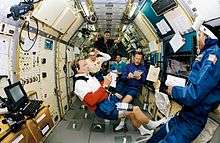
Among the GAS Cansisters was G-102, sponsored by the Boy Scouts of America's Exploring Division in cooperation with the TRW Systems Integration Group, Fairfax, VA. The project was named Project POSTAR and was the first space experiment created entirely by members of the Boy Scouts of America.
The mission, scheduled to end on September 19, was extended for one more day to complete certain experiments.
Also on board were two experiments prepared by Ashford School in Kent, United Kingdom, which, at the time, was a girls-only school.[2] The school had won a competition run by Independent Television News. The experiments were contained in G-520. The first one injected a few grams of cobalt nitrate crystals to a sodium silicate to create a chemical garden in weightless condition. The growths, which were photographed 66 times as they developed, spread out in random directions, twisted, and, in some cases, formed spirals. A second experiment to investigate how Liesegang rings formed in space failed to operate correctly due to friction in parts of the mechanism. On its return, the experiment was exhibited in the London Science Museum.[3]
See also
References
- "STS-47". Spacefacts. Retrieved 4 March 2014.
- "Apace shuttle mission STS-47 – Press kit". NASA. Retrieved 27 September 2010.
- "Late bloom for crystal garden". The New Scientist. 2 January 1993. Retrieved 27 September 2010.
![]()
.jpg)